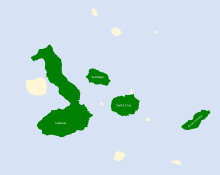
In evolutionary biology, adaptive radiation is a process in which organisms diversify rapidly from an ancestral species into a multitude of new forms, particularly when a change in the environment makes new resources available, alters biotic interactions or opens new environmental niches. Starting with a single ancestor, this process results in the speciation and phenotypic adaptation of an array of species exhibiting different morphological and physiological traits. The prototypical example of adaptive radiation is finch speciation on the Galapagos, but examples are known from around the world.
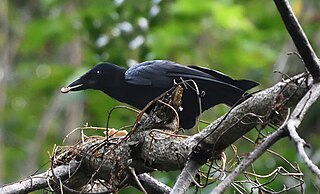
The New Caledonian crow is a medium-sized member of the family Corvidae, native to New Caledonia. The bird is often referred to as the 'qua-qua' due to its distinctive call. It eats a wide range of food, including many types of invertebrates, eggs, nestlings, small mammals, snails, nuts and seeds. The New Caledonian crow sometimes captures grubs in nooks or crevices by poking a twig at the grub to agitate it into biting the twig, which the crow then withdraws with the grub still attached. This method of feeding indicates the New Caledonian crow is capable of tool use. They are also able to make hooks. This species is also capable of solving a number of sophisticated cognitive tests which suggest that it is particularly intelligent. As a result of these findings, the New Caledonian crow has become a model species for scientists trying to understand the impact of tool use and manufacture on the evolution of intelligence.

Darwin's finches are a group of about 18 species of passerine birds. They are well known for their remarkable diversity in beak form and function. They are often classified as the subfamily Geospizinae or tribe Geospizini. They belong to the tanager family and are not closely related to the true finches. The closest known relative of the Galápagos finches is the South American dull-coloured grassquit. They were first collected when the second voyage of the Beagle visited the Galápagos Islands, with Charles Darwin on board as a gentleman naturalist. Apart from the Cocos finch, which is from Cocos Island, the others are found only on the Galápagos Islands.

The Galápagos hawk is a large hawk endemic to most of the Galápagos Islands.

Character displacement is the phenomenon where differences among similar species whose distributions overlap geographically are accentuated in regions where the species co-occur, but are minimized or lost where the species' distributions do not overlap. This pattern results from evolutionary change driven by biological competition among species for a limited resource. The rationale for character displacement stems from the competitive exclusion principle, also called Gause's Law, which contends that to coexist in a stable environment two competing species must differ in their respective ecological niche; without differentiation, one species will eliminate or exclude the other through competition.

The vampire ground finch is a small bird native to the Galápagos Islands. It was considered a very distinct subspecies of the sharp-beaked ground finch endemic to Wolf and Darwin Islands. The International Ornithologists' Union has split the species supported by strong genetic evidence that they are not closely related, and divergences in morphology and song. Other taxonomic authorities still consider it conspecific.
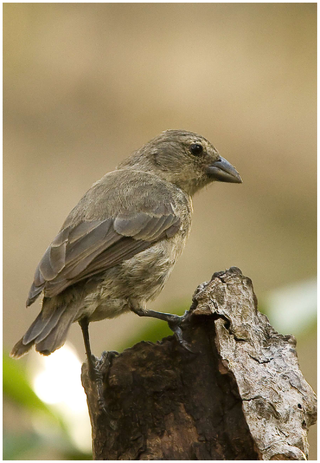
The mangrove finch is a species of bird in the Darwin's finch group of the tanager family Thraupidae. It is endemic to the Galápagos Islands. It was found on the islands of Fernandina and Isabela, but recent surveys have failed to record the species on Fernandina. It has been classified as critically endangered by BirdLife International, with an estimated population of 20–40 mature individuals in 2021, located in two large mangroves on Isabela. A study has shown that the two small populations remaining on Isabela Island have begun undergoing speciation and that one or both populations will eventually become extinct due to a lack of interbreeding.

The small tree finch is a bird species belonging to the Darwin's finch group within the tanager family Thraupidae. It has a grasping beak with curved culmens. Its natural habitats are subtropical or tropical dry forests and subtropical or tropical dry shrubland. During the non-breeding season it is known to form large groups with small ground-finches.

Camarhynchus is a genus of birds in the tanager family Thraupidae. All species of Camarhynchus are endemic to the Galápagos Islands, and together with related genera, they are collectively known as Darwin's finches. Formerly classified in the bunting and American sparrow family Emberizidae, more recent molecular genetic studies have shown it to belong in the tanager family.

The medium tree finch is a critically endangered species of bird in the Darwin's finch group of the tanager family Thraupidae. It is endemic to the Galápagos Islands where it is only found on Floreana Island. Its name is derived from the fact that the bird's beak is intermediate in size between that of the small tree finch and the large tree finch. Because it has a very small range on a single island, and because of the introduction of a parasitic fly which kills the nestlings, the International Union for Conservation of Nature has rated the medium tree finch as "critically endangered".

The large tree finch is a species of bird in the Darwin's finch group of the tanager family Thraupidae. It is endemic to the Galapagos Islands.

The medium ground finch is a species of bird in the family Thraupidae. It is endemic to the Galapagos Islands. Its primary natural habitat is tropical shrubland. One of Darwin's finches, the species was the first which scientists have observed evolving in real-time.

The common cactus finch or small cactus finch is a species of bird in the Darwin's finch group of the tanager family Thraupidae. It is endemic to the Galapagos Islands, where it is found on most islands, with the notable exception of Fernandina, Española, Genovesa, Darwin and Wolf. Most of these islands are inhabited by its close relative, the Española cactus finch.
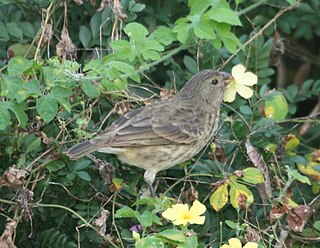
The vegetarian finch is a species of bird in the Darwin's finch group of the tanager family Thraupidae endemic to the Galápagos Islands. It is the only member of the genus Platyspiza.

Conolophus pallidus is a species of lizard in the family Iguanidae. It is one of three species in the genus Conolophus and is endemic to Santa Fe Island in the Galapagos.

Philornis downsi, also known as the avian vampire fly, is a species of fly that was first recorded in Trinidad and Brazil in the 1990s. It has been accidentally introduced to the Galapagos Islands (Ecuador). Adults of P. downsi feed on fruit. Eggs are laid in bird nests and hatch into parasitic larvae that reside in the nest material and emerge at night to feed both internally and externally on the blood and flesh of developing nestlings. The parasite causes significant mortality in Darwin's finch nestlings and threatens the survival of some rarer species such as the mangrove finch and the medium tree finch. To protect the threatened finch populations, insecticide-laced cotton has been supplied as nesting material for the finches, with the results being highly successful in combating P. downsi infestations at a localized scale. Currently, Biological pest control agents, including Conuraannulifera, are being investigated for their potential safety and efficacy in eradicating P. downsi on the Galapagos Islands.
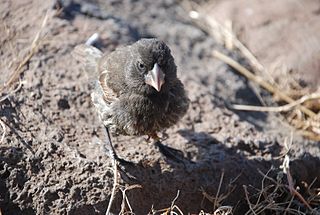
The Española cactus finch, is a species of bird in the tanager family Thraupidae. It is one of Darwin's finches, and is endemic to the Galápagos islands, where it is restricted to Española, Genovesa, and the Darwin and Wolf Islands. This rather dark bird resembles the smaller and finer-beaked common cactus finch, but the two species do not co-inhabit any island.

The Daphne Major finches are a group of Darwin's finches that inhabit Daphne Major island of the Galápagos. The common cactus finch and the medium ground finch are the main species; while the large ground finch and the Española cactus finch are regular immigrants. Most extensively studied by Peter and Rosemary Grant of Princeton University since 1973, the birds are one of the sources of the understanding of bird behaviour, adaptation, and evolution.
Asilo de la Paz is a location on Floreana Island in the Galapagos archipelago. It is the site of Floreana's first human settlement, and is now among the island's most popular tourist attractions. The site has a maximum elevation of 450 meters above sea level.

